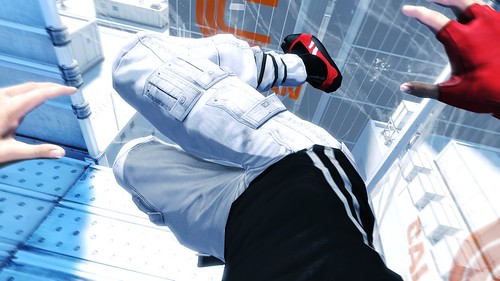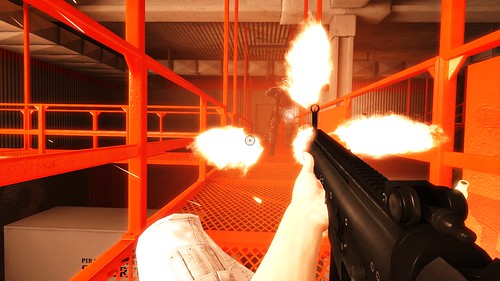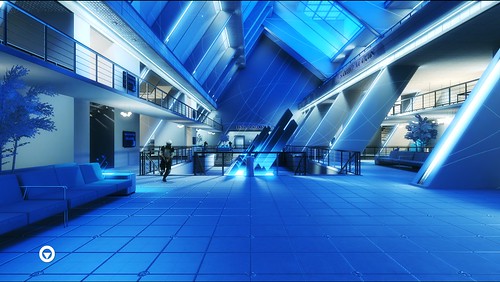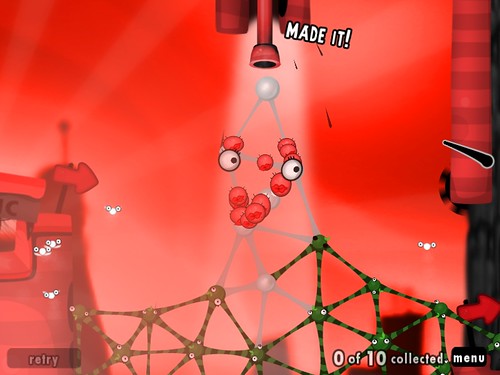TOM FRANCIS
REGRETS THIS ALREADY
Hello! I'm Tom. I'm a game designer, writer, and programmer on Gunpoint, Heat Signature, and Tactical Breach Wizards. Here's some more info on all the games I've worked on, here are the videos I make on YouTube, and here are two short stories I wrote for the Machine of Death collections.
Theme
By me. Uses Adaptive Images by Matt Wilcox.
Search
The Combat In Mirror’s Edge And Why It Fucking Sucks
Having played it through three times in English and once in Italian, it’s starting to look like I might be obsessed with Mirror’s Edge. This is my fifth post about it, and not my last. But even I think the combat is weirdly bad, and so easily fixable that you start to wonder what went on in DICE’s offices. There’s no way they had a roomful of testers play this and everyone said “Yep, seems fine.”
The three parts of it suck in different ways, and my proposed fixes are of equal obviosity.
Like Tuesdays, the melee combat in Mirror’s Edge has no feel. Despite loading-screen guff about run-ups giving your flying kicks more damage, every blow bounces off every enemy, triggering a fake ‘stagger’ animation. Nothing is physical, everything is the result of abstract rules.
If I, an unarmed action hero, manage to run at a firing gunman and flying-kick him in the face before he kills me, it has to knock him down. Look into your hearts, DICE, you know this to be true. It’s a fundamental axiom of awesome, like glass breaking when I dive through it. The same goes for slide-kicks to the groin, which should lift your victim momentarily from the ground as he’s propelled backwards onto his ass.
Punches should be weak, of course, which is precisely why there shouldn’t be any. You’re a slim woman with unprotected hands, it’s just not wise to hit someone wearing full body armour. If you’re sprinting when you collide with them, the impact should make them stagger. If you’re stationary, Attack should do the same as Disarm – recall that the Disarm button is actually the “Beat them up and disarm them” button.
Waiting for an enemy’s weapon to flash red during a specific frame of the same nonsensical shoulder-nudge they each perform is preposterous. I feel like I’m standing there as a favour to the game’s animators, because they only know how to show me grabbing a wrist in one particular position. It’s a terrible challenge, relying either on using slow-mo so slow that the wait becomes boring, or learning the animations by rote to anticipate the absurdly brief red flash.
Design tip! You’re supposed to hide – not force me to study – ridiculous conceits like canned animations.
Disarming should always work – slowly if they’re firing at you when you initiate it, quickly if they’re staggered or prone. Enemies shouldn’t try to nudge you with their weapons in close combat: you’re still in front of their gun, there’s no reason for them to stop firing. Instead they should start to run backwards as you approach, trying to keep you at a distance.
I love all the different words reviewers have found for this: loose, hollow, shaky, weak, fuzzy, bland. Obviously to make an unprecedented free-running game you can’t devote the time and budget it would take to make a really punchy shooter too. I wish DICE had seen the bright side of this, though: they didn’t have to! Shooting doesn’t have to take up the player’s time or be their source of fun. You can just have guns outright fucking kill people, the way they actually would.
Hitman’s the closest model of what I’m talking about: it doesn’t make a great shooter and it doesn’t have to. You spend most of your time in situations where you can’t viably open fire, so enemies don’t have to be tough and interesting challenges when you do. They can just die.
Once you’ve got hold of a gun in Mirror’s Edge, it should make a lot of noise, have a lot of kick, miss a lot at range, but kill when it hits.
If some of this sounds like it would make the combat too easy, that might be because I think the combat should be easy. But I also think it should be used in a completely different way, and I think I’m going to have to make that post number 6.
P.S. Graham’s blog Zeitgasm has also been redesigned, and is also harping on about Mirror’s Edge in tones I mostly agree with. 83% though, honestly.
Art And Motion In Mirror’s Edge

PC Gamer’s wildly inaccurate review of Mirror’s Edge went up recently, in which Graham Smith criminally under-rates the game at 83%. My own review, for PC Format, gives it the score it so obviously deserves – 84%. Unfortunately they don’t put their reviews online, so run-don’t-walk to your local newsagents – or to the United Kingdom if you’re not already there.
The colours in Mirror’s Edge look like the cordial from which normal hues are diluted. They’ve found a new way of rendering them that dazzles, almost glows. Even when it’s just a warehouse or factory you’re clambering through, every surface has that fresh paint smell, newly dried matte too smooth and lustrous to have ever been touched. There’s the sad sense of a city gleamingly maintained but otherwise unused.
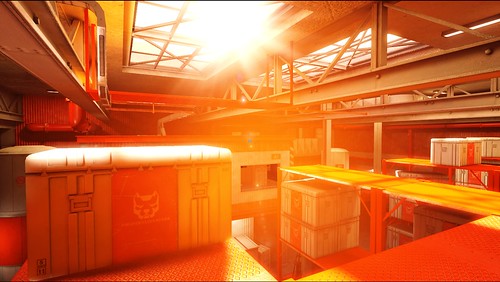
But beyond that, the design of the place constantly excites me. It’s the burden of level artists that they can’t just be level artists, they have to be architects, interior decorators, graphic designers, key grips, feng shui consultants and engineers. The buildings of Mirror’s Edge suggest its level artists actually are architects, interior decorators and graphic designers, moonlighting at DICE for some extra cash. If there are real offices that look this hip, I’m applying.
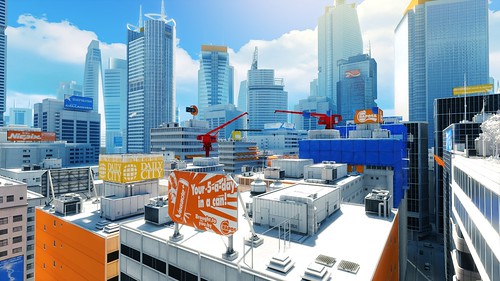
The game’s acceleration-based first-person parkour movement system does scratch the N itch, as I’d hoped. The second time through, with the route-highlighting Runner Vision off, is a new experience. This time you speak the language of the levels, and can pronounce your responses with new and fluid verbs. What I appreciate most about it, over third-person platformers, is the freedom of direction when launching myself from whatever wall I’m clung to, running along or flipping from – it gives scope for an elegance that isn’t pre-orchestrated like Prince of Persia’s.

I’m not keenly interested in major shortcuts – the fastest possible routes skip large chunks of the levels, but they’re large chunks I like. For me the finesse is in corner-cutting on a smaller scale: jumping to the center of a high-beam instead of tip-toeing its whole length, tucking to clear a huge jump fully rather than hauling yourself over the threshold, wallspringing to avoid a slow pipe clamber.
Strung together, flourishes like this surf the game’s acceleration mechanic and cannon you into a hurtling pelt. The little thrill of extra speed you get for vaulting an obstacle is a subtle but satisfying pat on the back for mastering the game’s unique nuances of environmental interaction.
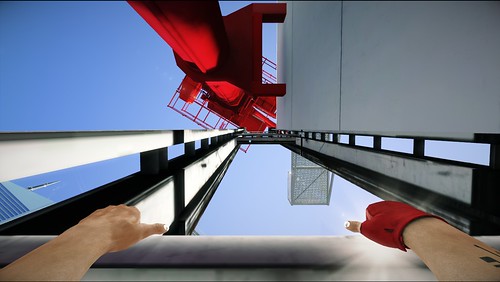
The main thing wrong with the platforming is the grabbing logic – it’s inconsistent, and it can’t afford to be. Some objects, like bars, can be grasped when your hands are more than a foot away, other ledges I’ve physically hit and still wasn’t able to hang onto. The platforming was never too difficult, to me, but every time I died without knowing why my character didn’t grab the ledge to which I’d propelled her, the irritation was vast.
Of course, that’s not the main thing wrong with Mirror’s Edge. Find out what is in my next post: The Combat In Mirror’s Edge And Why It Fucking Sucks.
P.S. If you hear any drilling, notice any scaffolds or strange new constructions around here, it’s because I’m tinkering behind the scenes a bit. James 2.7 will, I think, go up bit by bit over the course of this week. It’s too hard to prototype most of this stuff offline.
Mirror’s Edge In Pictures
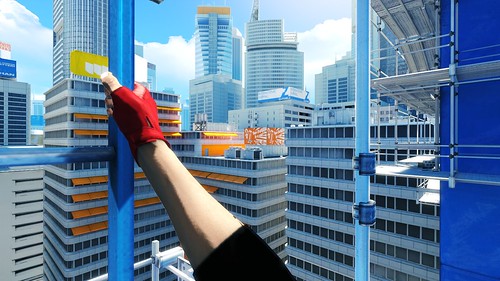
Just put some of my Mirror’s Edge shots up, and it turns out they make a rather nice slideshow. I’ll have another post or two about it this week.
Update! Fishbro points out that watching this slideshow whilst listening to the game’s theme song, Still Alive (!), quote “Felt good.” I therefore embed it here, that you might stream it in the background while opening the slideshow (which has expanded a fair bit) in a new tab and watching it full-screen. GOOD DAY.
PC Gamer Podcast 24: Admiral Failure & General Vague

Discussers: Tim Edwards, Tom Francis, Craig Pearson and Steve Williams.
Discussees: Crayon Physics Deluxe, Saints Row 2, Mirror’s Edge, Dawn of War 2, Red Alert 3, real-time strategy’s problems, Penguins Arena, Pipe Mania, our picks for the best developer comma ever full stop, Railroads and Sins of a Solar Empire.
Subscribe: here.
Listen:
Mass Effect In Wheels
I love the breadth of choice Mass Effect’s dialogue wheels give you sometimes:

Or the classic:

For some reason it drives me crazy when I can tell, before or after selecting an option, that my character would have delivered the same line no matter what I clicked. For the unfamiliar, Shepard doesn’t say the words you click on, but rather something to that effect. Sometimes there are alarming differences between the two, more often it’s clear the line was phrased to fit all three choices.
If you can’t give me the option, don’t give me the option. There’s plenty of meaningful choice in Mass Effect, punctuating it with meaningless choice only undermines it by making the developers seem lazy and the player’s choices irrelevant.
Plus side, some of them are so good I have to go away and make a cup of coffee before deciding:

I was surprised and pleased to find a lot of commenters here are fans too – I thought any of the other games I mentioned in my last post were more likely to spark a discussion. If you’re playing through at the moment, make sure you hit up Garrus for any old cop stories. My biggest regret when reviewing was that I didn’t follow that lead up before the game ended, and doing so on my second, more Paragonian playthrough was profoundly satisfying.
Bonus points to anyone who knows which two encounters those last decision wheels are from.
2008 In Games That Were Better Than Other Games
I like those gaming-moments-of-the-year lists, but they don’t always tell you what the best games were or even what they were like. So mine’s a games-of-the-year list, but with defining moments instead of descriptions. There’s often a particular experience in a game that exemplifies its appeal, usually the one that springs to mind when you fancy playing it. I’m talking about those rather than highlights or secrets – though often they coincide. This’ll be spoiler-free – indeed, it will at times say nothing meaningful at all – and in descending order: best first.
It’s: a huge open-world action RPG set in Washington two hundred years after a global thermonuclear apocalypse. Wilted fifties chic mixed with zombies being decapitated in slow-motion.

Defining experience: The Oasis
I’m not going to say anything about where or what Oasis is, and the screenshot above isn’t from it. Most people probably complete Fallout 3 without ever finding it – I know I did, first time through. Oasis is just the crowning example of what made Fallout 3 my favourite game this year, and the main thing it has over Oblivion.
I’d heard of it, but I wasn’t looking when I found it. I was just investigating some interesting rocks, as one likes to do on a Sunday. The wasteland is generally pretty flat, but I’d found a complex network of valleys and crags that looked like they might contain something interesting. They did.
Despite its size, and despite is apparent barreness, every interesting-looking place actually is interesting. It doesn’t have Guilds like Oblivion, so its content isn’t organised into neat little mini-careers your character can systematically complete. It’s sown evenly throughout its blasted landscape, leaving little pockets of story, character, treats, secrets and unique treasures.

It’s a brave choice. More people will miss more of Fallout 3’s most extraordinary moments than they did with Oblivion. But once you realise it, once your pessimism about this next house, cave or Vault being a generic one has been disproved often enough, it evokes an explorer’s excitement that I don’t get anywhere else.
But I wish: the skills were more fairly balanced. Small Guns and Repair are just flat out more effective than the others. Melee and Unarmed are crippled because you can’t target bodyparts, and Lockpicking gets its arse kicked by Science because most locked things have a hackable terminal to unlock them.
It’s: a co-operative horror shooter for four people, in which the tide of zombies and superzombies intensifies towards the end of each hour-long campaign.

Defining experience: “TANK!”
“I’ll throw a-”
“Oh God, I’m on fire!”
“So am I!”
“So am I!”
“Hunter!”
“So’s the Hunter!”
“I’ve got him. Look out for the Smo- ack!”
“I’m coming!”
“Help!”
“I’m coming!”
“Aaaargh!”
“I can’t move right now, and I’m still very much on fire, but I am coming!”
“Aaaargh! Look out for the-”
“Aaaaaaargh!”
“AAAAAAH!”
“AAAAAHHH!”
“AAAAAAH!”
“AAAAAAAAAAHH!”
“Heheh. Again?”
But I wish: there was a difficulty mode where the first four levels are frantic, but the finale isn’t impossible. And that Versus mode was just the latter two maps of a campaign, and the Director would give the losing side the Tank earlier or at the same time as it did the winning side.
It’s: a squishy building game in which you conjoin sentient goo-balls with different physical properties to reach your goal.
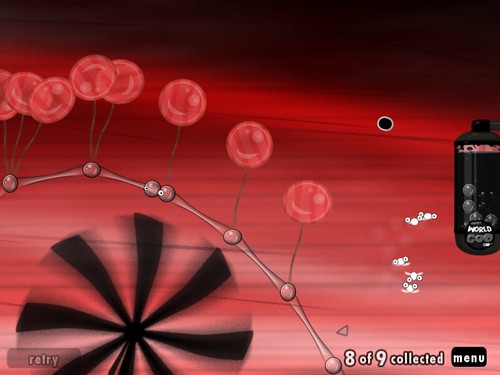
Defining experience: A Blustery Day
Not my favourite level – that’s Red Carpet – but Blustery Day is more typical of World of Goo. A new style of art that the level’s theme exquisitely, a booming score far too stirring for a physics game, and a smart new kind of puzzle that seems impossible until it occurs to you, obvious thereafter.
But I wish: there were fewer simple levels. Early on this makes sense, but later there are one or two where the task is simple but daunting – building a very long bridge, or a very tall tower. I never hit a difficulty spike in World of Goo – it’s eerily close to flawless – but on these few the challenge felt fussy rather than creative.
It’s: a creative adventure in which you play every phase of a species’ life, from the microscopic to the interstellar, designing how it evolves along the way.

Defining experience: “Holy shit, what’s that?”
Spore’s riddled with Star Trek references, but there’s a more profound one that’s not explicit: here’s the game where you seek out new life. There’s an actual galaxy to explore, and you’ll meet species that perhaps one other human has ever seen: their creator.
I know a lot of people got pretty hung up on what they expected from Spore, or what else Spore could have been – and that is an interesting discussion. But I hope it didn’t blind anyone to what Spore actually is: an extraordinary exploration of human creativity, and the home of the most astonishing creatures I’ve ever seen.
But I wish: the other stages were integrated into the Space stage: fight an eco disaster by designing an anti-virus that you then control in the Cell game, impress a warlike race by beating their champion in the Creature game, claim a planet without a colony module by beaming down and starting a Tribe, or mind-control an enemy leader from orbit and take his planet by winning a Civilization game.
It’s: a sci-fi action RPG with guns and science-magic in which you captain a spaceship to search for a single evil alien.
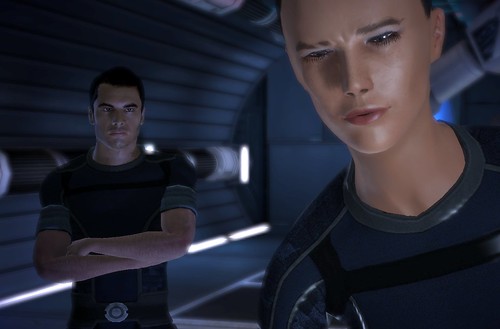
Defining experience: “I’ve had enough of your snide insinuations.”
Actually that’s not the defining experience, but anyone who’s played it and said that line knows why it springs to mind whenever you try to nail down why Mass Effect is so much better than ordinary RPGs. For anyone who hasn’t played it yet, be sure to say it if you ever get the chance.
For me the defining experience was when I’d landed on a new planet, and was asked by security to surrender my weapons. I wasn’t going to do it. Thinking like a gamer, I’d assume the designers would never kill me while I’m defenseless. But I’d become so wrapped up in the character that BioWare’s writers, my decisions, and Jennifer Hale’s exemplary voice acting had collaborated to produce that I wasn’t thinking like a gamer anymore. I was thinking go to hell. You want my weapons? Come and fucking take them, see what happens.
I won’t spoil what the outcome was, but the moral of the story is this: trust Mass Effect. It’s so well written and exciting that you’ll find yourself slipping into a role that’s very much your own – stick with it, and you’ll find the story moulds around it beautifully.
But I wish: exploring a new planet felt a bit more like exploring a new planet. The Mako fun-bus was jarringly at odds with the serious tone of the game, I’d much rather have beamed down on foot.
